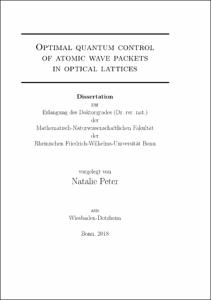Peter, Natalie: Optimal quantum control of atomic wave packets in optical lattices. - Bonn, 2019. - Dissertation, Rheinische Friedrich-Wilhelms-Universität Bonn.
Online-Ausgabe in bonndoc: https://nbn-resolving.org/urn:nbn:de:hbz:5n-54455
Online-Ausgabe in bonndoc: https://nbn-resolving.org/urn:nbn:de:hbz:5n-54455
@phdthesis{handle:20.500.11811/7917,
urn: https://nbn-resolving.org/urn:nbn:de:hbz:5n-54455,
author = {{Natalie Peter}},
title = {Optimal quantum control of atomic wave packets in optical lattices},
school = {Rheinische Friedrich-Wilhelms-Universität Bonn},
year = 2019,
month = may,
note = {In this work, I investigate the motional control and the transport of single neutral atoms trapped in an optical conveyor belt. The main goal is to prepare the atoms in the vibrational ground state of the trapping potential with high efficiency and keep the atoms in this state after fast non-adiabatic transport. In this group, the conveyor belt is used in two systems: (i) In an atom-cavity system, the three-dimensional ground state is prepared by means of carrier-free Raman sideband cooling for the first time. (ii) I use one-dimensional microwave sideband cooling in a state-dependent optical lattice and analyze with a new temperature model the influence of the anharmonic shape of the trapping potential. In the next step, I present a numerical simulation of atom transport. Optimal quantum control theory is used to find transport sequences for different durations without heating atoms out of the ground state. The measurements with these new sequences demonstrate that atoms can be transported by a factor two faster, with higher fidelity and robustness against experimental imperfections. Additionally, I analyze the dynamics of atom transport for sequences of multiple transport steps, which are required for quantum walk experiments. A proof-of-principle measurement demonstrates open-loop live feedback optimization of transport sequences with the experiment. This technique can further compensate experimental imperfections that are not taken into account in the numerical calculation. In the last part, I examine the fundamental limit of fast atom transport, the so-called quantum speed limit. It is defined as the minimum time that a quantum state requires to evolve into an orthogonal one. I investigate the dependencies of this boundary on different trap depths and the finite radial temperature.},
url = {https://hdl.handle.net/20.500.11811/7917}
}
urn: https://nbn-resolving.org/urn:nbn:de:hbz:5n-54455,
author = {{Natalie Peter}},
title = {Optimal quantum control of atomic wave packets in optical lattices},
school = {Rheinische Friedrich-Wilhelms-Universität Bonn},
year = 2019,
month = may,
note = {In this work, I investigate the motional control and the transport of single neutral atoms trapped in an optical conveyor belt. The main goal is to prepare the atoms in the vibrational ground state of the trapping potential with high efficiency and keep the atoms in this state after fast non-adiabatic transport. In this group, the conveyor belt is used in two systems: (i) In an atom-cavity system, the three-dimensional ground state is prepared by means of carrier-free Raman sideband cooling for the first time. (ii) I use one-dimensional microwave sideband cooling in a state-dependent optical lattice and analyze with a new temperature model the influence of the anharmonic shape of the trapping potential. In the next step, I present a numerical simulation of atom transport. Optimal quantum control theory is used to find transport sequences for different durations without heating atoms out of the ground state. The measurements with these new sequences demonstrate that atoms can be transported by a factor two faster, with higher fidelity and robustness against experimental imperfections. Additionally, I analyze the dynamics of atom transport for sequences of multiple transport steps, which are required for quantum walk experiments. A proof-of-principle measurement demonstrates open-loop live feedback optimization of transport sequences with the experiment. This technique can further compensate experimental imperfections that are not taken into account in the numerical calculation. In the last part, I examine the fundamental limit of fast atom transport, the so-called quantum speed limit. It is defined as the minimum time that a quantum state requires to evolve into an orthogonal one. I investigate the dependencies of this boundary on different trap depths and the finite radial temperature.},
url = {https://hdl.handle.net/20.500.11811/7917}
}






